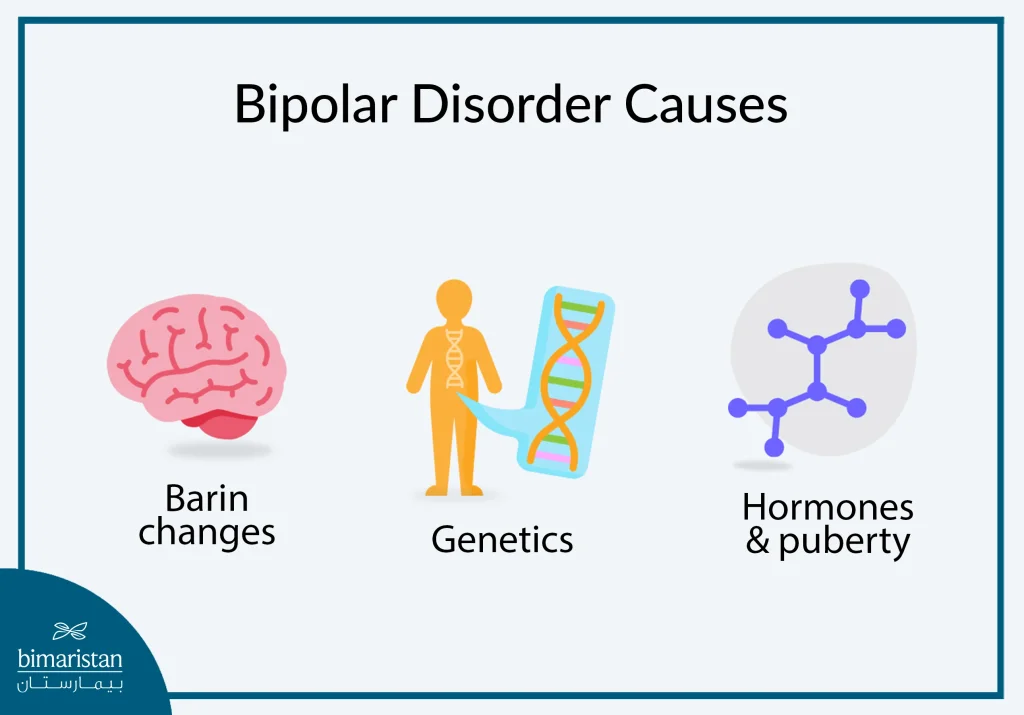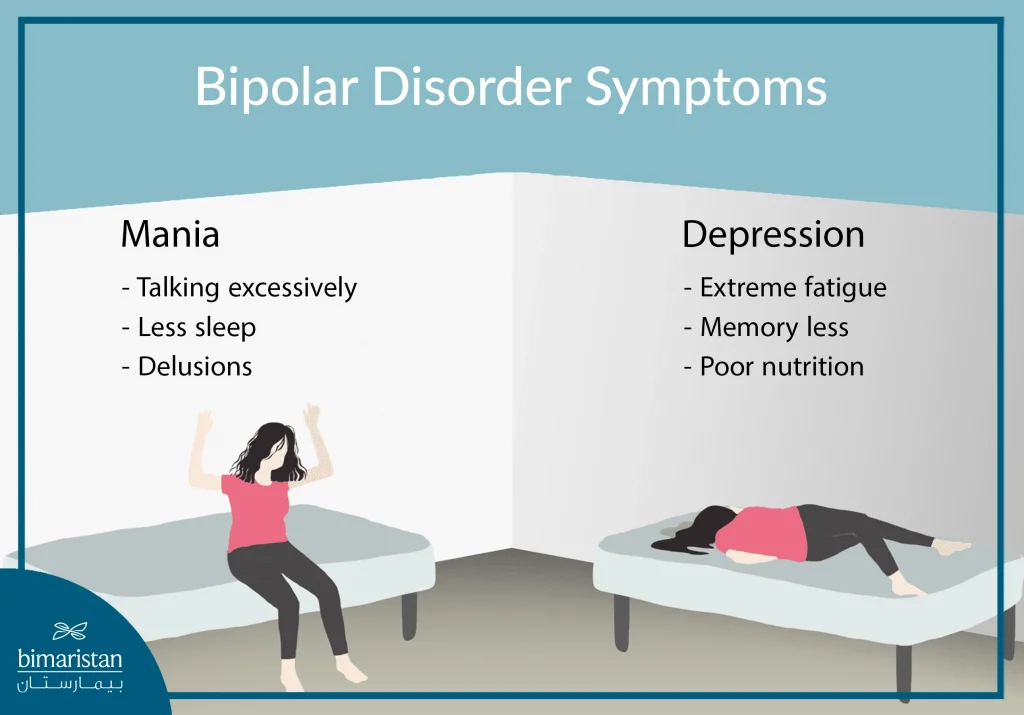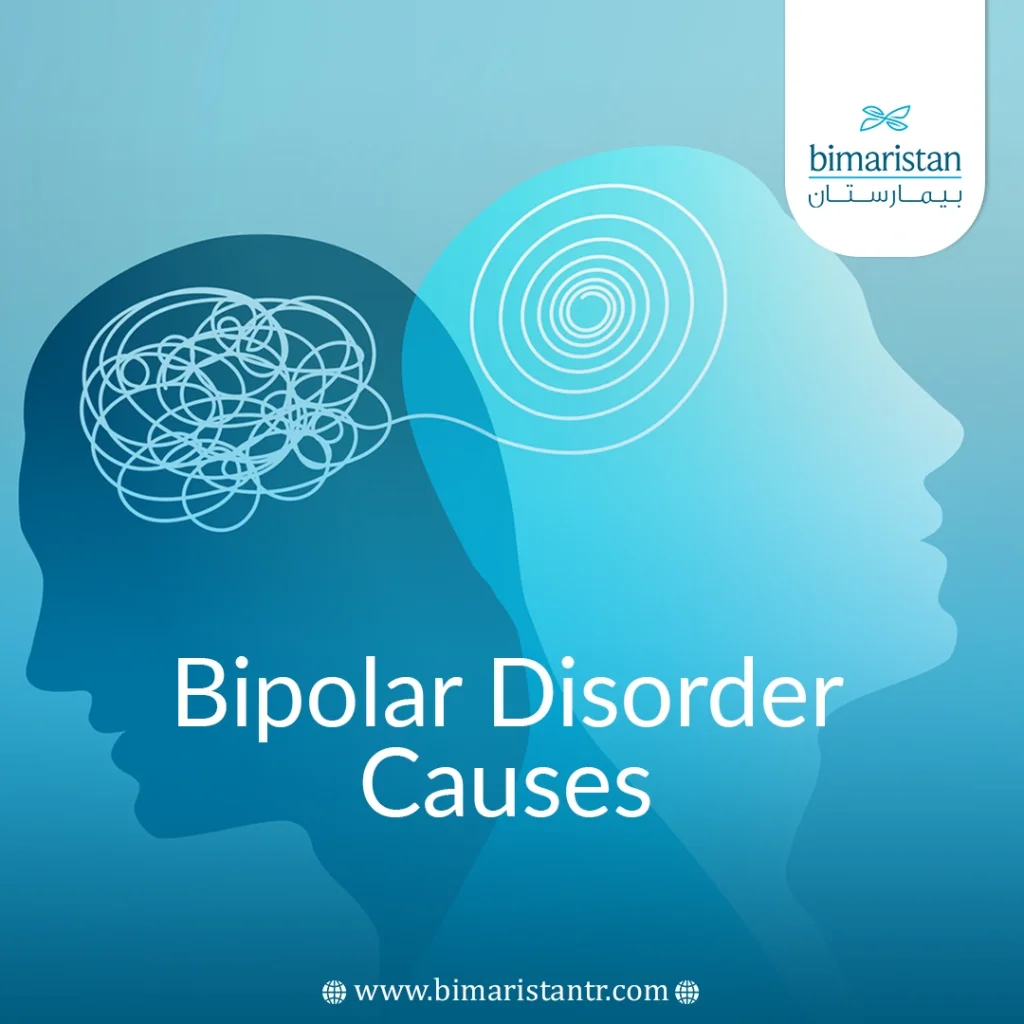Bipolar disorder is a chronic mental disorder that affects mood, energy, and daily activity levels. It is characterized by recurring episodes of mania and depression, making the sufferer suffer from severe mood swings that may affect their personal and professional life. Understanding bipolar disorder causes plays an essential role in dealing with it and minimizing its adverse effects.
Although the exact bipolar disorder causes is still not fully understood, research suggests that several factors influence its development, including genetics, chemical changes in the brain, and environmental influences. Therefore, delving deeper into the bipolar disorder causes will help develop more effective treatments and improve the quality of life for those affected.
What is bipolar disorder?
Bipolar is a psychiatric disorder characterized by extreme mood swings ranging from manic or hypomanic episodes to depressive episodes. During depressive episodes, the sufferer feels very sad and loses interest in life, while during manic episodes, the sufferer feels hyperactive, overly happy, or unusually irritable. These mood swings can occur sporadically or repeatedly throughout the year and affect sleep, energy, behavior, and decision-making. Although bipolar disorder is lifelong, its symptoms can be managed through medication and psychotherapy.
Types of Bipolar Disorder
- Bipolar I disorder: Characterized by severe manic episodes that may require hospitalization and may be accompanied by periods of hypomania or depression.
- Bipolar II disorder: Includes episodes of major depression and hypomania without reaching full-blown mania.
- Cyclothymia: The sufferer experiences mild mood swings lasting at least two years.
- Other types: Bipolar symptoms may be caused by certain drugs or medical conditions such as stroke or multiple sclerosis.
What is the difference between borderline personality disorder and bipolar disorder?
Although borderline personality disorder and bipolar disorder share some symptoms and are often confused, they are two very different conditions.
A borderline personality disorder is characterized by a persistent pattern of sudden fluctuations in mood, behavior, and self-image, usually as a result of interpersonal conflicts. Non-suicidal self-harm, which is not seen in bipolar disorder, is also a common symptom.
Bipolar disorder differs from BPD in that it involves distinct and long-lasting episodes of mania or hypomania as well as depressive episodes. A variety of factors, such as changes in sleep, stress, medication, or substance abuse may trigger these episodes.
Bipolar disorder causes
Although the exact causes of bipolar disease are not known, several factors may play a role in its onset, such as:
- Biological differences: Studies have shown that people with bipolar disorder have physical changes in their brains, but the significance of these changes and their impact on the disease is still unclear, and more research is needed to understand their role.
- Genetic factors: Bipolar disorder is more common in people who have a first-degree relative with the disorder, such as a parent or sibling, and researchers are still trying to determine the causes of bipolar illness and associated genes.
- Stress and pressure: Going through periods of extreme stress, such as losing a loved one or experiencing a traumatic accident, is one of the main causes of bipolar illness.
- Drug abuse: Shabu addiction or excessive alcohol use.
- Infection: Infection with the Toxoplasma gondii parasite that causes toxoplasmosis may be associated with an increased risk of bipolar disease.
Although unclear, bipolar disorder causes may be the result of biological, genetic, and environmental factors interacting to cause bipolar disorder, making diagnosis and treatment dependent on understanding the factors at play in each case.

Symptoms of Bipolar Disease
People with bipolar disorder experience extreme mood swings that affect their daily lives. These fluctuations range from episodes of hyperactivity and high energy, known as mania or hypomania, to periods of deep depression that make even simple tasks seem difficult. These changes do not follow a fixed pattern. They can last for short periods or last for weeks and vary in severity from person to person.
Symptoms of mania and hypomania
High levels of activity and energy characterize mania, but it can be more intense and may lead to a loss of contact with reality (psychosis):
- Hyperactivity or feeling overconfident
- Lack of need for sleep
- Talking unusually fast and distracted
- Making impulsive decisions such as irrational spending or taking unconsidered risks
Symptoms of major depression
During a depressive episode, a person has difficulty performing daily activities due to the following symptoms:
- Feelings of sadness, hopelessness, or emptiness
- Loss of interest in daily activities
- Significant changes in weight and appetite
- Sleep disturbances and constant fatigue
- Difficulty concentrating and making decisions
- Thinking about or attempting suicide

Additional symptoms and disorders associated with bipolar disorder causes
People with bipolar may experience additional symptoms such as severe anxiety, psychosis, or rapid mood swings. Symptoms may change according to the seasons or during pregnancy and may be more complex in children and adolescents because they are difficult to distinguish from normal emotional fluctuations.
How to Diagnose Bipolar Disease
If a doctor suspects bipolar disorder or another mental health condition, he or she will make a referral to a mental health professional such as a psychiatrist. The specialist begins by talking to the patient about their mood, behavior, and overall health and reviewing their family history to see if genetic factors play a role.
Diagnosing bipolar disorder can take some time due to the variety of symptoms and how it affects different people, as well as the similarity of symptoms to other mental health disorders. Diagnosis usually involves several steps, including:
- Physical examination: Your doctor will perform physical and lab tests to check for any medical issues responsible for your symptoms.
- Mental health assessment: The patient is referred to a psychiatrist who discusses the patient’s feelings and behavior and may ask the patient to answer a series of questions. The doctor may contact family members or close friends for more information about the symptoms.
- Mood mapping: You may be asked to keep a daily mood log or notes about your sleep and other behavioral patterns. This can help doctors make a correct diagnosis and develop an appropriate treatment plan.
Diagnosis in children
The same criteria that are applied to adults are used when diagnosing children and adolescents with bipolar disorder, but the symptoms may be different in these age groups. Often, symptoms may not fit into the specific diagnostic categories, and children may be diagnosed with other conditions, such as attention deficit hyperactivity disorder (ADHD) or behavioral issues, which can complicate the diagnosis. In such cases, children may need to consult a psychiatrist who specializes in pediatric bipolar disorder.
Treatment methods for bipolar patients
Proper treatment of the disorder is crucial after the exact causes of bipolar have been identified, as it aims to improve symptoms and regulate mood in the long term. A psychiatrist best does treatment with experience in treating bipolar disorder.
Because bipolar disorder is a chronic, lifelong condition, managing it requires ongoing treatment to manage symptoms and avoid acute episodes. Treatment depends on the needs of each individual and may include several options, including:
Bipolar medications
Treatment often requires starting mood-altering medications that include the following main medications:
- Mood stabilizers: Such as lithium and valproic acid, help control episodes of mania and depression.
- Antipsychotics: Such as olanzapine and risperidone, which act as mood stabilizers and help control manic episodes.
- Antidepressants: Your doctor may prescribe antidepressants with caution, as they can trigger manic episodes when used without mood stabilizers.
- Anti-anxiety medications: Such as benzodiazepines, which are usually used on a short-term basis to relieve anxiety and improve sleep.
Side effects of medications
Patients may experience some side effects from the medications. Over time, these side effects may improve with dosage adjustments or adaptation to the medication. It is essential for patients to work with their healthcare professionals to choose the most appropriate medicines for them.
It is essential to continue taking medications for life even if symptoms improve, as stopping treatment can lead to a relapse or worsening of symptoms.
Talking therapy
Initial and long-term treatment can help prevent symptoms from returning. Talking therapy can help children and teens adjust better, deal with learning disabilities, improve social issues, and strengthen family bonds and communication. If needed, talk therapy can treat alcohol or drug abuse issues common in older children and adolescents with bipolar disorder.

Psychoeducation
Psychoeducation can include learning about the symptoms, how bipolar disorder causes illness, and how they differ from age-related behavior and culturally appropriate attitudes and behavior. Knowing more about bipolar disorder can also help support the child.
Interpersonal and Social Rhythm Therapy (IPSRT)
It focuses on optimizing daily and biological life rhythms to reduce manic or depressive episodes, Aims to improve communication between family members, and provides psychoeducation.
Cognitive behavioral therapy
It helps patients analyze their thoughts and emotions and work on adopting more positive and healthy thinking patterns.
Self-management strategies
It includes strategies such as education and identifying early symptoms of manic or depressive episodes or potential triggers that lead to episodes. These strategies can help control the condition and improve daily life.
Useful Lifestyle Habits
An essential part of supporting treatment is adopting healthy habits such as:
- Exercise to improve mood and overall health
- Practicing yoga and meditation to reduce stress and improve mood
- Keeping a daily diary or mood chart can help identify triggers that may contribute to seizures
- A healthy sleep schedule is essential to regulate mood and prevent fluctuations
These healthy habits do not replace medical treatment, but they do play a supportive role in improving symptoms.
Intensive outpatient or partial hospitalization programs
These programs provide intensive support, including ongoing counseling sessions to help patients manage symptoms. In cases of emergency or danger, the patient may need to be hospitalized for follow-up treatment.
Electroconvulsive therapy (ECT)
In cases that do not respond to medication or when rapid symptom control is necessary, electroconvulsive therapy (ECT) may be used. This treatment is mainly used to treat severe, medication-resistant depression or life-threatening manic episodes.
Because bipolar disorder is an ongoing condition, treatment requires a long-term commitment. A treatment plan may take several months or even years to reach an optimal solution.
At Bimaristan Medical Center, we recognize that bipolar disorder is an ongoing condition that requires a long-term commitment to treatment and that the variety of bipolar disorder causes makes it challenging to diagnose appropriately. Our specialized team works alongside you to develop a comprehensive treatment plan that may take several months or even years to reach the best solution. We are here to provide you with ongoing support and personalized care to achieve emotional and psychological stability and improve your quality of life.
Sources:
